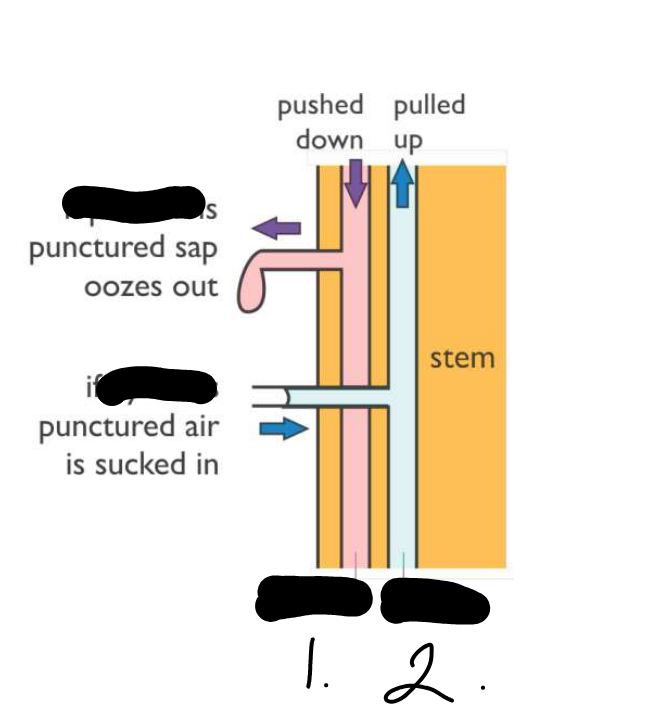evidence of mass flow in phloem and xylem
1/11
There's no tags or description
Looks like no tags are added yet.
Name | Mastery | Learn | Test | Matching | Spaced |
|---|
No study sessions yet.
12 Terms
puncture experiment
If the phloem is punctured with a hollow tube then the sap oozes out, showing that there is high pressure (compression) inside the phloem (this is how maple syrup is tapped). If the xylem is punctured then air is sucked in, showing that there is low pressure (tension) inside the xylem. This illustrates the main difference between transport in xylem and phloem: sap is pushed down in the phloem, while water is pulled up in the xylem

1.phloem 2. xylem
Ringing experiments
Since the phloem vessels are outside the xylem vessels, they can be selectively removed by cutting a ring in a stem just deep enough to cut the phloem but not the xylem. After a week there is a swelling above the ring, reduced growth below the ring and the leaves are unaffected. This 17th century experiment was early evidence that sugars were transported downwards in the phloem.
what is an isotope
isotopes have an extra neurone increasing the mass.
what does radioactive mean
An unstable form of a chemical element that releases radiation as it breaks down and becomes more stable
Explain what Autoradiography
Where a radioactive sample is placed on a normal piece of photographic film in the dark. The radioactive radiation fogs the film. This is very useful for locating radioactive chemicals in living or dead organisms, chromatography sheets or electrophoresis gels
Geiger Counters,
Where the radioactive radiation is detected using a Geiger-Muller (GM) tube. This method is quick but not very sensitive or precise.
Scintillation Counting
where radioactive samples are mixed with a chemical that emits light (scintillates) in the presence of radioactive radiation, and the light detected with a light sensor. This method is the most sensitive, but tedious.
An experiment using radioactivity
In a typical experiment a plant is grown in the lab and one leaf is exposed for a short time in the light to carbon dioxide containing the radioactive isotope 14C. This 14CO2 will be taken up by photosynthesis and the 14C incorporated into glucose and then sucrose. The plant is then frozen in liquid nitrogen to kill and fix it quickly, and placed onto photographic film in the dark. The resulting autoradiograph shows the location of compounds containing 14C. This experiment shows that organic compounds (presumably sugars) are transported downwards from the leaf to the roots. More sophisticated experiments using fluorescently labelled compounds can locate the compound specifically to the phloem cells.

Aphids experiment
Aphids (or greenfly), have specialised mouthparts called stylets, which they use to penetrate phloem tubes and sup of the sugary sap therein. If the aphids are anaesthetised with carbon dioxide and cut off, the stylet remains in the phloem, and phloem sap continues to ooze out of the stylet. So pure phloem sap can be collected through the stylet for analysis to measure its composition or flow rate under different conditions or in different species. This surprising technique is more accurate than a human with a syringe, doesn’t damage the phloem and the aphids enzymes ensure that the phloem and the aphids enzymes ensure that the stylet doesn’t get blocked
what does mass flow hypothesis not explain
how different solutes can move at different speeds or even in different directions in the phloem
why translocation stops if the sieve tube cells and companion cells are killed
what does it explain
the fast speed of solute translocation
the high pressure in the sieve tubes